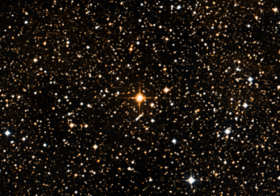UY Scuti facts for kids
 DSS2 image of red supergiant star UY Scuti (brightest star in the image), surrounded by a dense starfield. |
|
| Observation data Epoch J2000 Equinox J2000 |
|
|---|---|
| Constellation | Scutum |
| Right ascension | 18h 27m 36.5334s |
| Declination | -12° 27′ 58.866″ |
| Apparent magnitude (V) | 8.29 - 10.56 |
| Characteristics | |
| Evolutionary stage | Red hypergiant |
| Spectral type | M2-M4Ia-Iab |
| U−B color index | +3.29 |
| B−V color index | +3.00 |
| Variable type | SRc |
| Astrometry | |
| Radial velocity (Rv) | 18.33±0.82 km/s |
| Proper motion (μ) | RA: 1.3 mas/yr Dec.: −1.6 mas/yr |
| Parallax (π) | 0.5166 ± 0.0494 mas |
| Distance | 9,500±1,030 ly (2,900±317 pc) |
| Absolute magnitude (MV) | −6.2 |
| Details | |
| Mass | 7–10 M☉ |
| Radius | 1,708±192 R☉ |
| Luminosity | 340,000+290,000 −160,000 L☉ |
| Surface gravity (log g) | −0.5 cgs |
| Temperature | 3,365±134 K |
| Other designations | |
|
UY Sct, BD−12°5055, IRC −10422, RAFGL 2162, HV 3805
|
|
| Database references | |
| SIMBAD | data |
UY Scuti (also called BD-12°5055) is a huge red supergiant star. It is found in the constellation called Scutum. This star is one of the biggest stars known by its size.
UY Scuti is also a pulsating variable star. This means its brightness changes over time. It can be as bright as magnitude 8.29 and as dim as magnitude 10.56. Its estimated size is about 1,708 times bigger than our Sun. This makes its volume nearly 5 billion times larger than the Sun!
The star is about 9,500 light-years away from Earth. If UY Scuti were in the center of our Solar System, its outer edge would reach past the orbit of Jupiter.
Contents
How UY Scuti Got Its Name
UY Scuti was first recorded in 1860 by German astronomers. They were working at the Bonn Observatory. They were creating a list of stars for the Bonner Durchmusterung Stellar Catalogue.
The star was first named BD-12°5055. This name meant it was the 5,055th star found between 12 and 13 degrees south of the celestial equator.
Later, astronomers noticed the star's brightness changed. This showed it was a new variable star. Following international rules for naming variable stars, it was called UY Scuti. This name means it was the 38th variable star found in the constellation Scutum.
UY Scuti is located a few degrees north of the star Gamma Scuti. It is also northeast of the Eagle Nebula. Even though UY Scuti is very bright, it looks dim from Earth. This is because it is very far away. It is also hidden by a lot of dust in a part of space called the Cygnus rift.
What Makes UY Scuti Special?

UY Scuti is a very bright red supergiant star. It is covered in a lot of dust. It is known as a semiregular variable star. This means its brightness changes in a somewhat regular pattern. This pattern repeats about every 740 days.
In 2012, scientists used a special telescope in Chile. It was called the Very Large Telescope (VLT). They used a technique called interferometry to measure UY Scuti. They found that UY Scuti is more than 1,000 times bigger than our Sun. It is also over 100,000 times brighter than the Sun.
Scientists calculated UY Scuti's size to be about 1,708 times the size of the Sun. This was based on its angular diameter and its distance. Its temperature is about 3,365 K.
Imagine an object traveling at the speed of light. It would take about seven hours to go around UY Scuti. To compare, it would only take 14.5 seconds to go around our Sun!
Newer measurements of UY Scuti's distance have been made by the Gaia spacecraft. These measurements suggest the star might be closer. If it is closer, then its size and brightness would be smaller than first thought. However, these new measurements might not be fully accurate yet. This is because there is a lot of "noise" in the data.
Scientists believe UY Scuti's mass is between 7 and 10 times the mass of the Sun. The star is losing some of its mass every year. This creates a large cloud of gas and dust around it.
What Will Happen to UY Scuti?
Scientists believe UY Scuti has started to fuse helium in its core. It also continues to fuse hydrogen in a layer around its core. UY Scuti is located deep inside the Milky Way galaxy. This means it is a "metal-rich" star.
Eventually, UY Scuti will start to create iron in its core. When this happens, the balance between gravity and radiation inside the star will break. This will cause the star to explode in a huge event called a core collapse supernova.
Before it explodes, stars like UY Scuti are expected to change. They might become hotter, turning into a yellow hypergiant or a Wolf–Rayet star. These stars have very strong winds. These winds blow away the outer layers of the star. This exposes the core. After this, the star will explode as a Type IIb, Type IIn, or Type Ib/Ic supernova.
See also
 In Spanish: UY Scuti para niños
In Spanish: UY Scuti para niños



